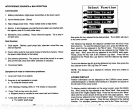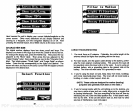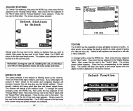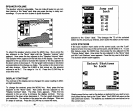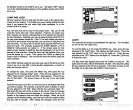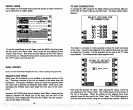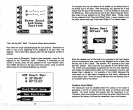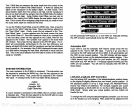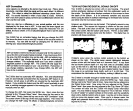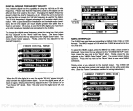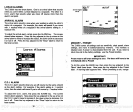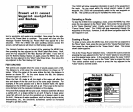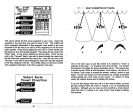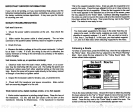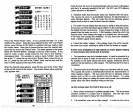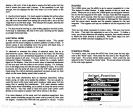
ASE Correction
Loran
signals
are affected
by
the terrain
they
travel over.
Plains, lakes,
mountains,
and cities
affect the
signal
and
they
each affect it in different
ways.
This effect is called the
additional
secondary phase
factor,
or
ASF. It's
usually
factored in
when a loran chart is made.
However,
ASF's
vary
from
place
to
place,
so there can be differences between the
chad and the real world.
There can also be a
difference in
your
actual
position
and the one
displayed
by
the
bran,
due to ASF. In this
case,
the loran
signals
are
distorted from their theoretical
position.
Since
the
measured ID's are
shifted,
the loran shows a ID or
latitude/longitude
that is not the actual
position.
The Z-9500
has an correction feature that lets
you change
the ASF.
This forces the loran to use a new ASF instead of the one that resides in
its
memory.
You
can shift the ASF
by changing
the TD offset or
by
entering your
actual
latitude/longitude position.
The
Z-9500 also has automatic ASF selection. TD's and
latitude/longi-
tude are
automatically
corrected when the Automatic ASF feature is on.
However,
not all areas in all GAl's are covered
by
the Automatic ASF
feature, If
you
enable this feature and the ASF's aren't available in
your
area,
a
warning message appears
in the
message
box. You will have to
manually
enter an ASF.
To
change
the
ASF,
first
press
the MENU
key. Next, press
the
key
adjacent
to the
"Change Setup"
label. Now
press
the
key
next to the
"More"
label.
Finally,
press
the
key
next to the "ASF Correction" label.
The screen shown
at the
top
of the next
page appears.
This menu lets
you change
the ASF
using
TD offsets or
latitude/longitude correction,
TURN AUTOMATIC/DIGITAL SONAR ON/OFF
Your Z-9500 is
actually
two sonar units in one
housing.
The
graph
portion graphically displays
all echoes from the underwater
world on
the screen. The
digital
sonar
displays
numbers on the screen to show
the
depth
of the bottom. It is an
extremely complex
and accurate
device
using
the latest in software
technology
to
elimihate false echoes
and show
only
the true bottom
depth.
However, any digital
sonar can be. fooled.
This
typically
occurs in
very
shallow water. The reason this
happens
is shown on
the two charts
below. First look at the chart on the left. The sonar
signal penetrates
the surface
clutter,
hits the bottom and returns. There's a clear differ-
ence between the surface clutter and the bottom. The
digital
has no
problem
with these conditions.
0
10
Problems occur when the surface clutter
extends to the bottom as
shown on the
right.
The
digital
sonar cannot
distinguish
between
surface clutter and the bottom and so it
becomes "lost." It
may
flash
the last known bottom
depth
or it
may
lock onto an
unrealistic
depth
such as 900 feet in a lake that
only gets
60 feet
deep
at its
deepest
point.
If the unit is in
automatic,
the
auto-ranging
feature
may change
the
range
to an
extremely deep depth,
such as 0
to 600 feet. This
compresses
the information
on the
display, making
it difficult to read.
The Z-9500 is versatile
enough
to handle these situations. If it shows
these
symptoms
in
shallow
water,
press
the MENU
key.
Next,
press
the
key
next to the "More" label 2 times. Now
press
the
key adjacent
to
the
Digital
Sonar label. Now
press
the
key adjacent
to the
"Digital
Sonar" label. Now
press
the
key adjacent
to the
"Dig.
Sonar Off" label.
The screen will clear and the Z-9500 will
display
sonar information
again.
You
may
need to
change
the
range
to
0-10
or
0-20 feet. If there
is a lot of "clutter" or random echoes on the
screen,
turn the
sensitivity
down until a definite bottom echo is seen. Use the unit in
this manner
until
you
move into
deeper
water. Once
you're
in
deeper water,
the
digital
and automatic features can be turned back on
by simply press-
ing
the AUTO
key.
IMPORTANT!
ASF corrections
entered
by
the user are
good only
for the stations in
use at the time and
location
being
corrected. If
you
travel
away
from
the
area,
the ASF correction
may
not be
valid. ASF corrections
may
not be usable if
you change stations,
or
if
the unit
automatically
changes
stations. This
especially
holds true if
you
enter a latitude/
longitude position
to
change
ASF. The Z-9500 will
only apply
the
ASF correction to the stations in use
-
not all of
them.
Remember,
if
you change
stations,
especially
if
you change GAl's,
the ASF will
have to be re-entered.
94 43
PDF compression, OCR, web-optimization with CVISION's PdfCompressor



